United States Sanitary Commission
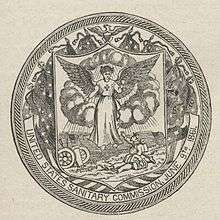

The United States Sanitary Commission (USSC) was a private relief agency created by federal legislation on June 18, 1861, to support sick and wounded soldiers of the U.S. Army during the American Civil War.[3] It operated across the North, raised an estimated $25 million in Civil War era revenue (assuming 1865 dollars, $387.12 million in 2016) and in-kind contributions[4] to support the cause, and enlisted thousands of volunteers. The president was Henry Whitney Bellows, and Frederick Law Olmsted acted as executive secretary. It was modeled on the British Sanitary Commission, set up during the Crimean War, and from the British parliamentary report published after the Indian Rebellion of 1857.[5]
History
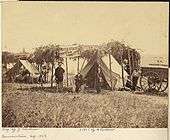
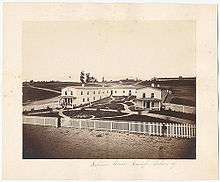
Henry Whitney Bellows, a Massachusetts clergyman, planned the USSC and served as its only president.[6] According to The Wall Street Journal, "its first executive secretary was Frederick Law Olmsted, the famed landscape architect who designed New York's Central Park".[7] George Templeton Strong, New York lawyer and diarist, helped found the commission and served as treasurer and member of the executive committee.[8]

In June 1861, the Sanitary Commission setup its Central Office inside the Treasury Building downtown Washington, D.C. By late October 1861, the Central Office and the War Department had received detailed studies and reports from the Sanitary Inspectors of more than four hundred regimental camp inspections. The rapidly crowded events of those first six months of the war displayed the sheer gravity of the situation in which the adjustment to the means and agencies were desperately needed to ensure a high health-rate in all those untrained Union regiments.[9]
Immediately following the First Battle of Bull Run, the first orders and receipts submitted to the Central Office began to arrive from the military Union hospitals at Alexandria, Virginia, and Washington, D.C., requesting water-beds, small tables for writing in bed, iron wire cradles for protecting wounded limbs, dominoes, checkerboards, Delphinium and hospital gowns for the wounded.[10]
The demands of the war soon required more frequent decision-making. This led to the creation of the Standing Committee, which met on a nearly-daily basis in New York City where most of its members resided. The Standing Committee initially consisted of five commissioners who retained their position for the entire war: Henry W. Bellows, George Templeton Strong, William H. Van Buren, M.D., Cornelius R. Agnew, M.D., and Prof. Wolcott Gibbs., M.D.[11]
Also active in the association was Col. Leavitt Hunt, a New York lawyer and photographer. In January 1864, he wrote to President Abraham Lincoln's secretary John George Nicolay asking that Nicolay forward him any documents he might have available with the President's signature. Hunt's mother, the widow of Vermont congressman Jonathan Hunt, planned to attach Lincoln's signature to copies of several casts of the President's hand, to be sold to raise funds for the war effort.[12]
Women in the USSC
Arising from a meeting in New York City of the Women's Central Relief Association of New York,[13] the organization was also inspired by the British Sanitary Commission of the Crimean War. The American volunteers raised money (estimated at $25 million), collected donations, made uniforms, worked as nurses, ran kitchens in army camps, and administered hospital ships, soldiers' homes, lodges, and rests for traveling or disabled soldiers. They organized Sanitary Fairs in numerous cities to support the Federal army with funds and supplies, and to raise funds for the work of the USSC.[14] Women who were prominent in the organization, often traveling great distances, and working in harsh conditions, included Louisa May Alcott, Almira Fales, Eliza Emily Chappell Porter, Katherine Prescott Wormeley, and many others.
Dorothea Dix, serving as the Commission's Superintendent, was able to convince the medical corps of the value of women working in their hospitals.[15] Over 15,000 women volunteered to work in hospitals, usually in nursing care.[16] They assisted surgeons during procedures, gave medicines, supervised the feedings and cleaned the bedding and clothes. They gave good cheer, wrote letters the men dictated, and comforted the dying.[17] A representative nurse was Helen L. Gilson (1835–68) of Chelsea, Massachusetts, who served in Sanitary Commission. She supervised supplies, dressed wounds, and cooked special foods for patients on a limited diet. She worked in hospitals after the battles of Antietam, Fredericksburg, Chancellorsville, Gettysburg. She was a successful administrator, especially at the hospital for black soldiers at City Point, Virginia.[18] The middle class women who volunteered provided vitally needed nursing services and were rewarded with a sense of patriotism and civic duty in addition to the opportunity to demonstrate their skills and gain new ones, while receiving wages and sharing the hardships of the men.[19]
Mary Livermore,[20] Mary Ann Bickerdyke, and Annie Wittenmeyer played leadership roles.[21] After the war some nurses wrote memoirs of their experiences; examples include Dix, Livermore, Sarah Palmer Young, and Sarah Emma Edmonds.
Sanitary Fairs
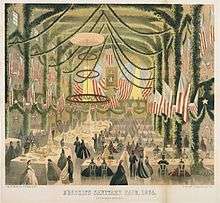
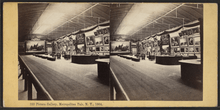
Organizing the Sanitary Fairs offered ways for local communities to be directly part of supporting the war effort of the nation. The first Sanitary Fair during the war was held in Chicago from October 27 to November 7, 1863. Called the Northwestern Soldiers' Fair, it raised almost $100,000 for the war effort. It included a six-mile-long parade of militiamen, bands, political leaders, delegations from various local organizations, and a contingent of farmers, who presented carts full of their crops. The fairs generally involved large-scale exhibitions, including displays of art, mechanical technology, and period rooms. These sorts of displays called upon ideas of the American past, a history that local communities held in common. Often, different communities competed with each other over their donations to the national cause. People in various cities and towns across the North contributed to the same war effort because they identified as having shared fortunes in their common nation.[22]
The USSC leadership sometimes did not approve of the excitement and lavishness of the fairs. They wanted to encourage sacrifice as a component of membership in a nation. Although the fairs were one way to create a national identity which might motivate citizens to perform their duties, the commission leadership did not want the fairs to become the focus of USSC work.[22]
In addition to setting up and staffing hospitals, the USSC operated 30 soldiers' homes, lodges, or rest houses for traveling or disabled Union soldiers. Most of these closed shortly after the war.[23]
The government constructed the Pension Building in Washington, DC to handle all the staff to process the pension requests and administer them. It is now listed on the National Register of Historic Places. After the war, the USSC volunteers continued to work with Union Army veterans to secure their bounties, back pay, and apply for pensions. It supported the "health and hygiene" of the veterans. They had a Department of General Relief which accepted donations for veterans, too.[14] The USSC organization was finally disbanded in May 1866.[24]

Notable members
- Henry Whitney Bellows served as the President of the Commission.
- Samuel Howe served as a Director of the Commission.
- Frederick Law Olmsted served as the Executive Secretary of the Sanitary Commission.
- George Templeton Strong was Treasurer of the Commission
- Louisa May Alcott served as a nurse for the Sanitary Commission at a Union Army Hospital in Georgetown.
- Mary Ann Bickerdyke served as a nurse for the Sanitary Commission and is credited with establishing 300 field hospitals during the Civil War
- Mary Livermore led the Northwestern Branch of the Sanitary Commission
States could use their own tax money to supplement the Commission's work, as Ohio did. Under the energetic leadership of Governor David Tod, a War Democrat who won office on a coalition "Union Party" ticket with Republicans, Ohio acted vigorously. Following the unexpected carnage at the Battle of Shiloh in April 1862, it sent three steamboats to the scene as floating hospitals with doctors, nurses and medical supplies. The state fleet expanded to eleven hospital ships. The state also set up 12 local offices in main transportation nodes to help Ohio soldiers moving back and forth.[25]
Legacy
The U.S. Sanitary Commission is memorialized by a group of re-enactors who portray the Boston branch of the commission at various civic events, educational programs, and Civil War re-enactments. The group is based out of the Greater Boston area of Massachusetts.
See also
- United States Christian Commission, a similar organization
- Western Sanitary Commission, a smaller rival based in St. Louis
- Hospital Ships of the Sanitary Commission
References
- ↑ Library of Congress Title
- ↑ Library of Congress Description title
- ↑ The official warrant or order for the organization of the Sanitary Commission appears to have issued from the War Department office, Sunday, 9 June 1861, and to have received President Lincoln's signature four days subsequently.
- ↑ Stillé, Charles J. (1866). History of the United States Sanitary Commission, Being the General Report of Its Work during the War of the Rebellion. Philadelphia: J. B. Lippincott & Co. p. 490. Retrieved April 9, 2014.
- ↑ The Sanitary Commission of the United States Army. A Succinct Narrative of Its Works and Purposes. New York: Sanitary Commission. 1864. p. 5. Retrieved August 4, 2015.. Also, "The New-York Times. Necessity of Sanitary Organization." (Vol. X, No. 3031: Sunday, June 9, 1861). p. 5, column 1. Retrieved: August 4, 2015. Additionally, the medical reports of Edmund Alexander Parkes including the British army medical dispatches, the findings of the Royal Sanitary Commission, and first-hand knowledge acquired by Florence Nightingale were compiled in her "Notes On the Care and Treatment of Sick and Wounded During the Late War in the East, and On the Sanitary Requirements of the Army Generally" (London: 1858). These were also considered in the establishment of the United States Sanitary Commission
- ↑ Sanitary Commission, p. 10. Rev. Dr. Bellows, President of the Commission, provided a graphic statement (following his preliminary tour through the Western encampments) in a letter to a New York auxiliary committee of finance. Camp diseases, the irregularity of life, exposure, filth, heat and crowded conditions were described in this letter.
- ↑ Dugan, Ianthe Jeanne (June 22, 2007). "Civil War Letters Shed Light on Pain Of Troop's Families". The Wall Street Journal. (subscription required (help)).
- ↑ Willis, John C. "George Templeton Strong". Sewanee: The University of the South. Retrieved July 17, 2010.
- ↑ Sanitary Commission. pp. 16 - 22.
- ↑ Sanitary Commission. pp. 14 - 15. Additionally, money donations were requested by the Sanitary Commission to support these military Union hospitals. These funds were received by George T. Strong, Treasurer of the Commission, 68 Wall Street, N.Y., and George S. Coe, Treasurer of Central Executive Committee, American Exchange Bank, N.Y.
- ↑ US Sanitary Commission records in the New York Public Library
- ↑ Letter from Col. Leavitt Hunt to John George Nicolay, January 1864, General Correspondence of Abraham Lincoln, American Memory, Library of Congress, accessed 23 September 2013
- ↑ Stillé, Charles J. (1866). History of the United States Sanitary Commission, Being the General Report of Its Work during the War of the Rebellion. Philadelphia: J. B. Lippincott & Co. pp. 40–62. Retrieved July 17, 2010.
- 1 2 "Great Central Fair Buildings, Philadelphia". World Digital Library. Retrieved 2013-07-28.
- ↑ Thomas J. Brown, Dorothea Dix: New England Reformer (Harvard U.P. 1998)
- ↑ Jane E. Schultz, "The Inhospitable Hospital: Gender and Professionalism in Civil War Medicine," Signs (1992) 17#2 pp. 363-392 in JSTOR
- ↑ Ann Douglas Wood, "The War within a War: Women Nurses in the Union Army," Civil War History (1972) 18#3
- ↑ Edward A. Miller, "Angel of light: Helen L. Gilson, army nurse," Civil War History (1997) 43#1 pp 17-37
- ↑ Elizabeth D. Leonard, "Civil war nurse, civil war nursing: Rebecca Usher of Maine," Civil War History (1995) 41#3 pp 190-207
- ↑ Wendy Hamand Venet, A Strong-minded Woman: The Life of Mary Livermore (2005)
- ↑ Elizabeth D. Leonard. "Civil War Nurse, Civil War Nursing: Rebecca Usher of Maine," Civil War History (1995): 41#3 190-207. in Project MUSE
- 1 2 Lawson, Melinda. Patriot Fires: Forging a New American Nationalism in the Civil War North, Lawrence, Kansas: University Press of Kansas, 2002.
- ↑ "Soldiers' Homes and Lodges" in The Sanitary Commission Bulletin 3:1279. Available at Google Books.
- ↑ "US Sanitary Commission historical website". Retrieved December 23, 2005.
- ↑ Eugene E. Roseboom, The Civil War Era, 1850-1873 (1944) p 396
Further reading
- Attie, Jeanie. Patriotic Toil: Northern Women and the American Civil War (1998), focus on the Sanitary Commission online edition
- Giesberg, Judith Ann. Civil War Sisterhood: The U.S. Sanitary Commission and Women's Politics in Transition (2006)
- Martin, Justin. Genius of Place: The Life of Frederick Law Olmsted (2011) pp 178–230
- Maxwell, William Quentin. Lincoln's Fifth Wheel: The Political History of the U.S. Sanitary Commission (1956) online edition
- Olmsted, Frederick Law. The Papers of Frederick Law Olmsted. Vol. 4: Defending the Union: The Civil War and the U.S. Sanitary Commission, 1861-1863 (1986) excerpt and text search
- Tise, Pam. "A Fragile Legacy: The Contributions of Women in the United States Sanitary Commission to the United States Administrative State" (Applied research project). Texas State University. (2013)
External links
| Wikimedia Commons has media related to United States Sanitary Commission. |
| Wikisource has the text of a 1905 New International Encyclopedia article about United States Sanitary Commission. |
- Sanitary Commission history, civilwarhome.com.
- United States Sanitary Commission records, 1861-1879 (bulk 1861-1872), held by the Manuscripts and Archives Division, New York Public Library
- The United States Sanitary Commission Philadelphia Branch collection, containing materials on several humanitarian efforts made by the association during the Civil War, are available for research use at the Historical Society of Pennsylvania.
- List of 30 USSC soldiers' homes, lodges, and rests in 25 cities in 15 states North and South in 1865.
